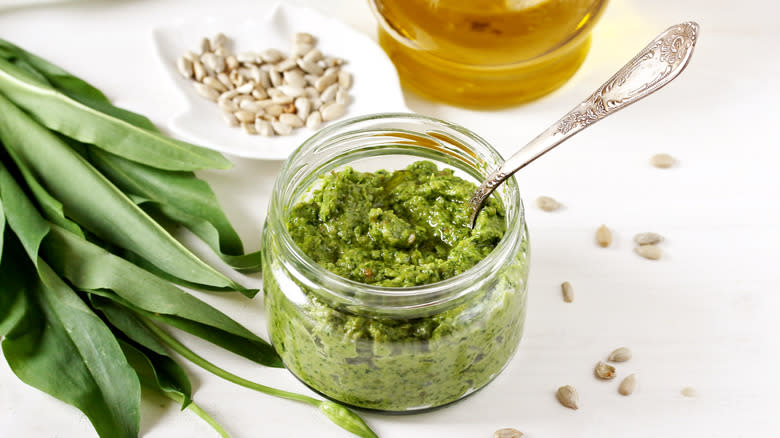Sunflower Seeds Are The Perfect Ingredient For A Nut Allergen-Free Pesto

If you're whipping up classic basil pesto, chances are the recipe calls for nuts. While pine nuts are pretty common, some recipes for this ancient Roman-rooted sauce suggest almonds or walnuts in their place. However, including any kind of nut in pesto can limit those who are allergic, or who simply don't like the taste of nuts.
For a nut-free alternative, try swapping in some sunflower seeds. Once processed along with the rest of the ingredients, the finished pesto will maintain a similar consistency to one with nuts: Smooth enough to use as pasta sauce, but thick enough to spread on a flatbread.
To make a simple, nut-free version of lemon basil pesto, blend sunflower seeds along with basil, garlic, lemon juice, Parmesan cheese, and oil, in a food processor or blender. Once the mixture is smooth and spreadable, it can be added to pasta as a sauce, spread on top of pizza crust, added to sandwiches, or used as a dip. And, if you want to further enhance the flavor of the pesto, there are a few ways to elevate the taste of sunflower seeds before adding them.
Read more: What These Imitation Foods Are Actually Made Of
How To Elevate The Flavor Of Sunflower Seeds

For some extra flavor, roast your sunflower seeds before adding them to the pesto recipe. On their own, the seeds have a mild nutty flavor. With a little roasting, however, that nuttiness will intensify, and help to add a new depth of flavor to the pesto.
Another way to enhance the taste of sunflower seeds is to toss them in oil and seasonings before roasting. You can toss the seeds in salt, pepper, or water-activated garlic powder to taste. Since oil is already drizzled in to create the proper consistency while the pesto is blending, a little extra from the seeds won't hurt.
In general, sunflower seeds are considered safe for those with nut allergies. The FDA reports that although sunflower seeds do share some similarities to Brazil nuts and walnuts, they're minimal enough that they won't affect most people. While it's always best to test for allergies to err on the side of caution, a sunflower seed allergy is considered fairly rare.
The Best Seeds To Use In Nut-Free Pesto

There are a few other ways to make pesto sans nuts if you aren't a fan of sunflower seeds. Sesame seeds can act as a suitable swap for the sauce. The seeds' mild flavor will allow the cheesy, herby flavors of the pesto to shine. They might even add a little creaminess to the sauce if blended well. (Blended sesame seeds create tahini, which is a key ingredient in hummus.)
Pumpkin seeds, which can also take the place of nuts, taste mild and are a little chewy. However, much like sunflower seeds, if you roast the pumpkin seeds before adding them to the pesto, they can take on a nutty taste. Since the seeds are a little larger than sesame or sunflower seeds, they may require some extra blending time to break down.
The next time you want to make a nut-free pesto, try swapping out the nuts for your favorite seeds. You'll wind up with a similar texture, and a sauce that's nut allergen-friendly, making it a better option for social gatherings.
Read the original article on Daily Meal.

